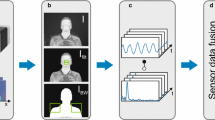Abstract
The breathing rate (BR) is one of most important physiological parameter used for cardiopulmonary arrest prevention and for evaluating respiratory problems as (sleep) apnea, congestive heart, hypo / hyper –ventilation, asthma etc. In this paper, we propose an efficient method for non-contact estimation of BR using thermal imaging. The system is based on computer vision algorithms and sequentially performs: face detection, interest points extraction and tracking, geometric transformation between successive frames and nostril position estimation. The performance of the proposed framework is evaluated against the BR measured using a wired thermistor. The thermistor is placed near the subject nostril and is connected to an acquisition system designed for medical applications. The experimental evaluation validates the proposed methodology, returning high accuracy scores. In terms of the computational complexity, the system performs the BR estimation in real time.
Preview
Unable to display preview. Download preview PDF.
Similar content being viewed by others
References
1. Cretikos M.A., Bellomo R., Hillman K., et al (2008) ”Respiratory rate: the neglected vital sign”, Med. J. of Australia, 188 (11) pp.657–659.
2. Seymour C.W., Kahn J.M., Cooke C.R., et al (2010)” Prediction of critical illness during out-of- hospital emergency care”, J. of the Amer. Med. Assoc. 304, pp. 747–754.
3. Camilo M.R., Sander H.H., Eckeli A.L.,et al (2014) „SOS score: an optimized score to screen acute stroke patients for obstructive sleep apnea”, Sleep Med. 15(9), pp. 1021-4.
4. Fieselmann J.F., Hendryx M.S., Helms C.M., et al (1993) “Respiratory rate predicts cardiopulmonary arrest for internal medicine inpatients”, J. of Gen. Internal Med. 8 (7) pp. 354–360.
5. Kenzaka T., Okayama M., Kuroki S., et al (2012)“Importance of vital signs to the early diagnosis and severity of sepsis: association between vital signs and sequential organ failure assessment score in patients with sepsis” Intern Med. 51(8), pp. 871-6.
6. Couceiro R., Carvalho P., Paiva R.P.et al (2014)“Detection of motion artifact patterns in photoplethysmographic signals based on time and period domain analysis” Physiol. Meas.35(12), pp. 2369–2388.
7. Cretikos M, Chen J, Hillman K, et al. (2007) „The objective medical emergency team activation criteria: a case–control study”, Resuscitation 73, pp. 62–72.
8. Klaudiny M. (2013) “High-detail temporally consistent 3D capture of facial performance”, Centre for Vision, Speech and Signal Processing, University of Surrey, UK.
9. Mostafa E., Hammoud R., Ali A., et al. (2013) “Face recognition in low resolution thermal images”, Comp. Vis. and Image Under., vol. 117(12), pp. 1689-1694.
10. Kwaśniewska A., Rumiński J.(2016) “Real-time facial feature tracking in poor quality thermal imagery,” 9th Int. Conf. on Human Sys. Inter. pp. 504-510.
11. Wang S., Liu Z., Shen P., et al. (2013)“Eye localization from thermal infrared images”, Patt.Recog.,46(10), pp. 2613-2621.
12. Basu A, Routray A, Mukherjee R, et al, (2016) “Infrared imaging based hyperventilation monitoring through respiration rate estimation”, Infrared Physics & Technology, 77, pp 382-390.
13. Viola P., Jones, M. J. (2004) “Robust Real-time Face Detection”, Int. J.Comput. Vis., 57(2), pp. 137–154.
14. Lowe D. (2004) “Distinctive Image Features from Scale-Invariant Keypoints”, Int. J.Comput.Vis..60(2), pp 91–110
15. Bay H.,Ess A., Tuytelaars T., Gool L.V. (2008) “Speeded-Up Robust Features (SURF)”, Comput. Vis. Image Underst., 110, 346–359.
16. Calonder M., Lepetit V., Strecha C. et al(2010) “Binary robust independent elementary features”. In: 11th Europ. Conf. on Comput. Vis. (ECCV) pp. 778-792
17. Tuzel O., Porikli O.; Meer F. (2006) “Region covariance: A fast descriptor for detection and classification” Europ. Conf. on Comput. Vis. (ECCV), 3952, pp. 589 -600.
18. Lucas B., Kanade T. “An iterative technique of image registration and its application to stereo”. IJCAI’81 Proc. of the 7th Int. joint conf. on Artif.Intel.1981, 2, pp.674-679.
19. Lee J. J., Kim G. (2007) “Robust Estimation of Camera Homography Using Fuzzy RANSAC”. Int. Conf. on Comput. Sci. and its App., pp. 992–1002.
Author information
Authors and Affiliations
Corresponding author
Editor information
Editors and Affiliations
Rights and permissions
Copyright information
© 2018 Springer Nature Singapore Pte Ltd.
About this paper
Cite this paper
Țarălungă, D.D., Mocanu, B., Țapu, R. (2018). Automatic real time derivation of breathing rate from thermal video sequences. In: Eskola, H., Väisänen, O., Viik, J., Hyttinen, J. (eds) EMBEC & NBC 2017. EMBEC NBC 2017 2017. IFMBE Proceedings, vol 65. Springer, Singapore. https://doi.org/10.1007/978-981-10-5122-7_21
Download citation
DOI: https://doi.org/10.1007/978-981-10-5122-7_21
Published:
Publisher Name: Springer, Singapore
Print ISBN: 978-981-10-5121-0
Online ISBN: 978-981-10-5122-7
eBook Packages: EngineeringEngineering (R0)




